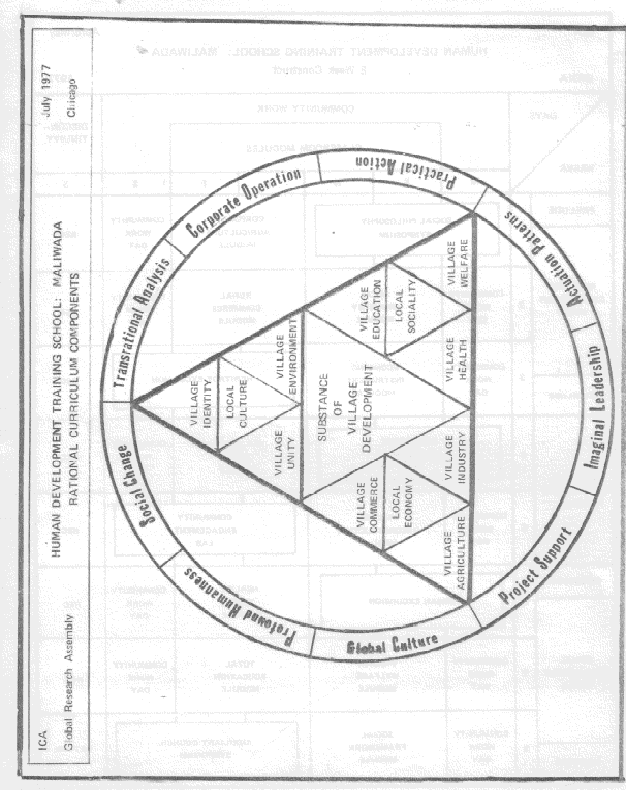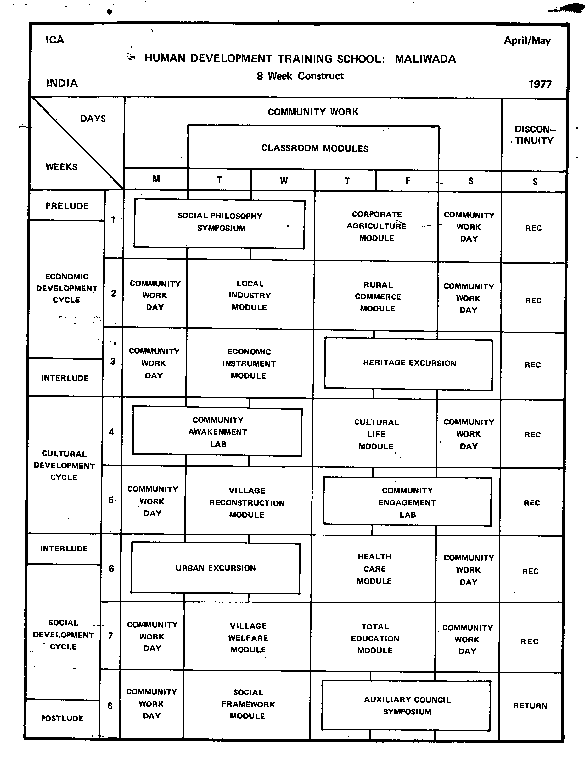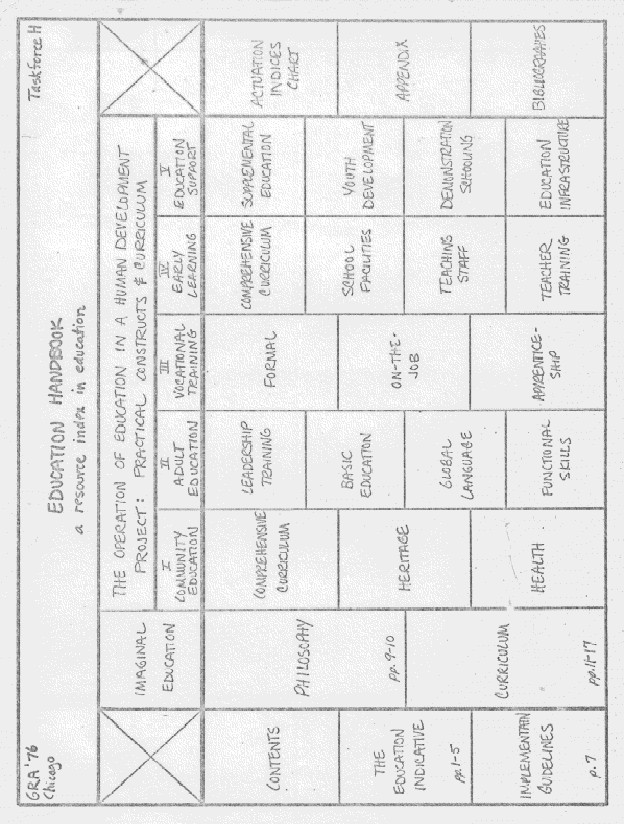
 |
 |
 |
| GRA '76 Education
CHICAGO Page 1
|
| CONSULTATION FINDINGS | Between August 1975 and July 1976 eight Human Development Consultations were held in eight communities around the globe in very diverse social and economic situations. The following paragraphs are an attempt to draw together the findings of those eight consultations in terms of what they reveal about local communities, particularly as they inform the needs in
education. |
| OPERATING VISION | In local communities across the globe local man is awakening to a new role ant responsibility toward the future. A new vision, practical and yet profound, is emerging and becoming part of his operating context and deep hope for life. His two moat basic desires, while quite different, are very much related. They are the desire to improve the physical condition of life and the desire to be a community. The upgrading of living conditions, namelyhealth and housing, and the extension of urban services transport, communication, water, power and sewage, for example, are seen as critical to increasing the functional capacity of human life. The recovery of community identity and pride through the intentional creation and beautification of public space, the re-instigation of meaningful community forms, and the recasting of the cultural heritage along with the engagement of all ages and racial groupings in the community points to a resurgence of community spirit without which new community cannot be born. Local communities want to develop and participate, have a voice in what is going on. Local man is concerned with raising the economic level of his community through a more intensive utilization of available physical, human, and technological resources and the systematic stimulation of the economy through the introduction of new industry and the development, expansion and coordination of local business and commerce. Finally, he sees as key to his community's future greater access to quality education at all levels, both formal and informal. |
| VISION OF
EDUCATION | Education, then, is the final repository for the hopes and dreams of local man. One of his most passionate concerns is for accessibility to the tools for significant participation in his community, his society and the globe. Not only does he want an education for himself and his children, but he is concerned with quality education that extends beyond the years of elementary schooling to include early learning, secondary schooling, adult education and vocational training in technical and, where applicable, agricultural skills. In terms of adult education, basic literacy for the total population is a foundational hope. In addition, the opportunity for continuing educational development is experienced as a crucial symbol of everpresent possibility. |
| UNDERLYING
CONTRADICTION | The one underlying contradiction in local community has to do with the fact that 15% of the earth's people possess 85% of the earth's resources and 15% of the earth's people have access to only 15% of the earth's resources. The one undelying contradiction in local community is this blocked access. It includes access to jobs, capital, education, information, services. This blocked access has resulted in subsistence living conditions in which many barely make it day to day and malnutrition and other such compromises between making it and not, debilitate efforts at improving the situation. The situation of subsistence living then holds in being a subsistence mindset in which only me and my survival this day are important. This fosters the loss of vision, the loss of meaning, and a depp uncooperativeness which absolutely block the future from being different fromthe present. |
| CONTRADICTION
FOR EDUCATION | In terms of education, the key contradiction to be dealt with is for this problem of imagination or the failure of vision. Signs of hope and possibility such as the Human Development Project itself will soon begin to deal with this. The next most critical contradiction has to do with adult knowhow or tooling, including basic literacy. The third has to do with exposure to the resources, lifestyles and images beyond the delimited experiences of the local community. |
| EDUCATION PROPOSALS | The Practical Proposals for education call for adult education, early learning, vocational and
apprenticeship training, literacy, health education, teacher training, leadership development, support for the existing educational structures and the development of youth. Adult education, which appeared most frequently, included the development of a community curriculum, methods instruction, community exposure and functional skills for operating to the advantage in your situation. |
| EDUCATION TACTICS | The education tactics include the development of a community faculty, curriculum, and educational funds pool, the establishment of new educational facilities, and the creation and operation of educational programs such as business and commercial skills, tourism, and dietary training which meet the particular needs of the local situation and enable its development. |
| EDUCATION PROGRAMS | The programs in education include for each of the eight sites the establishment and operation of a preschool or early learning center and an adult education program. Vocational and apprenticeship training is freighted in a number of different vehicles such as the Marshalls Training Corps and Urban Student House. Supplemental or supportive efforts in relation to the public schools emerge as programs in themselves and in some situations a demonstration school. While community education does not emerge as a program in itself, it nevertheless is the key to the total development of the community. Its content is held as the components of many other programs, especially in the social arena. |
| COMMUNITY
PARTICIPATION | In Community Education what is called for is a comprehensive curriculum involving all ages and providing a broad base of functional skills and imagery for operating in the present world as those who determine the future shape of things. To deal authentically with the future, the heritage of a people must be dealt with and appropriated through both the reinvigoration of old forms and the creation of new ones. Thus, exploration and study of the heritage becomes a critical component of the community's self-programming. In addition, in subsistence communities where malnutrition and unsanitary living conditions prevail, community wide health education is a concern. Programs in this arena include training in basic hygiene, sanitary practices, first aid care and diet and nutrition. |
| ADULT
EDUCATION | Adult education, which is, by far, the largest program component in the Human Development Projects shows up about 50 times in the 8 Human Development Projects. It is virtually a component, either explicitly or implicitly, of every major program. Of particular emphasis are Leadership Training by which is generally meant training in methods of community development and corporate action; Basic Education which includes the 3 it's, with a heavy beat on literacy; in nonEnglish speaking communities, learning the Global Language (English); and Functional Skills Training which is inclusive of most of the everyday, oftentakenforgranted techniques for operating in one's situation to best advantage, such as getting a job, balancing a checkbook, creating a budget, planning one's future, taking advantage of available services and resources, etc. This all underscores the fact that great attention is being required for the tooling of the adult member of every society for his emerging role of leadership in developing the resources of his community for the globe. |
| VOCATIONAL TRAINING | Next to Adult Education, Vocational Training included the largest number of program components with about thirty different mentions being made. These were identified primarily with adult and youth but were also recommended in several situations as components of the elementary schooling program. They include agriculture and fishing; trade skills such as drafting, construction and mechanics; business; clerical and secretarial skills; industrial operations; paramedical; education; rural management; pilot training (boat); animal husbandry; and merchandizing. The significance of Vocational Training for human development is twofold. First, it tools people for profitable employment thus increasing the income capacity of the community. Secondly, and perhaps most important, it gives people a way to engage and become productive human beings. |
| EARLY
EDUCATION | Early Education was proposed for each of the eight Human Development Projects. It is one component of the total community education program. It is important in Human Development Projects for these reasons:
1. To emphasize the importance of education for every member of the community. There is no human development without the simultaneous education or training in new skills, methods, and images for every member of that community.
2. The key to releasing the total energy of the community is the creation of structures of engagement that focus on the community as a whole and forge new patterns of relating beyond the family. The Preschool or Early Education Center also, very practically, frees the parents for more total vocational engagement.
3. Since the preschool age child is the prime victim of malnutrition, the Early Education Program can be a vehicle for delivering at least one wellbalanced nutritious meal per day to every child in the community.
4. Because of the family relationship, the Early Education Program also becomes a vehicle for parent and family training. 5. As a demonstration school, the Preschool becomes in and of itself an illustration of disciplined intentional corporate style in the community. |
| EDUCATION
SITUATION | It is very important that schools stand across the globe within reach of every human being as a symbol of the central importance of education for human living and as a sign that education is available to everyone. This has been one of the great accomplishments of the Twentieth Century. Nevertheless, the facts stand that
1. The existing facilities, staffing and materials are sufficient to serve only a fraction of the earth's total population, 2. Because of fees, distance, and lacking necessary infrastructure, schools are practically inaccessible to many people, especially in the more rural and more povertystriker situations of the world, 3. Education in our time is in a state of collapse everywhere in the world because it has not finished the process of retooling and restructuring itself to deal with a changed knowledge structure, lifestyle and global mood, 4. Teachers are having to learn all over again what it means to educate a human being. |
| SUPPLEMENTAL EDUCATION | In the midst of this situation, great new possibility exists as never before to redefine and recreate education in the context of local community and global responsibility. Supplemental Education is an attempt 1. to fill the cracks in training for the young in arenas in which the existing school structures are either in need of support for their efforts, e.g., teaching reading, or are not covering certain arenas, such as heritage, Twentieth Century worldview, planning and decisionmaking methods, or practical skills and 2. to provide a basic education for all youth of a community, whether or not they can afford the school fees or whether or not the present school facilities are adequate to handle total enrollment. |
| YOUTH
DEVELOPMENT | It has also been important in these projects, in light of the role that youth has assumed over the past ten years, to deal with the development of the youth as a vital resource to the community and to think through what kinds of skills and training he needs, apart from what the school may offer, to fulfill that role. It is particularly important as the community develops that youth have a way to grasp the basic tools and methods which make this development both an ongoing possibility and the challenge of a lifetime |
| DEMONSTRATION SCHOOLING | A Demonstration School is most feasible where an educational structure does not exist already but is being established as a result of the Human Development Project or where the inclination of the school administrator is to make the existing school part of the total Human Development Project and has, therefore, given permission to make certain alterations in the prescribed curriculum, format and operation of the school. Whatever the case may be, the school will, nevertheless, be affected by and a part of the total human development effort. |
| EDUCATION INFRASTRUCTURE | Finally, the programs call for the establishment of infra structures to reinforce the educational structures and secure the education of the total community in a variety of ways through the establishment of Parents Associations, Support Networks, Scholarship Funds, Enrollment Programs, Job and Graduate Placement Services and Teacher Training. These provide the ''glue" that relates the school and the community in their common desire to move people ahead. |
1. DELIMITED GEOGRAPHY
An educational demonstration of maximum effectivity
is related to the delimited geography of a Human Development Project
and the population of this geographical area. Education outside
the context of the total community life is, at best, without reinforcement
and tends to be abstracted from the real life of the people.
2. ALL THE PEOPLE
Serious education in a community serves the total population all ages, ethnic, racial and social groupings, both sexes, and every individual .
In the 20th century there is no reason why every
child in the globe cannot have quality education, although there
will never be the space or equipment available that some would
suggest are necessary to do this job. In the Fifth City Preschool
when faced with the limitations of space, virtually no equipment
and a very high child/teacher ratio, the staff found that it was
not only possible, but exciting to teach in that situation. If
the purpose of education is to allow children to live in the world
as it really is, it makes little sense to force children who are
daily exposed to the vitality of life all around them into a classroom
where they confront only one teacher and a few peers. \'hat they
experience in such a situation is not true to the way they experience
life. Thus, mass education, using imaginal education methods and
tools, breaks loose the creativity that is essential for human
development to take place.
3. ALL THE ISSUES ALL AT ONCE
Significant education deals with all of the issues
of human community all at once. For example, it deals with re-programming
the imagination at the same time as it deals with literacy. It
deals with the body and the spirit at the same time as it deals
with the intellect.
4. THE DEPTH HUMAN ISSUE
Effective education deals with the depth human issue
o£ community as well as with individuals. Relevant educational
curriculum is built off of the address of deep life questions.
Effective educational methods allow one to selfconsciously
reflect on the life issues confronting him.
5. SYMBOL IS KEY
Symbols are the key to shifting the basic images
out of which a human being operates which is the task of education.
The repeated use of simple songs' rituals, and visual symbols
that relate to the deeps of life, for example, is the way that
a message is communicated through an unreceptive screen to establish
a new pattern of behavior.